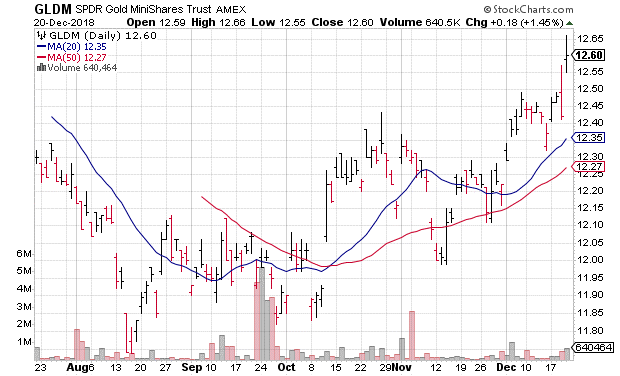Before we begin today, I want to wish you all a Happy Holidays!
It’s the day before Christmas for my family. But whatever celebration you are holding, I hope you are enjoying it!
With the markets tanking across the board in the U.S., we need a little holiday cheer right now.
Since I’m writing this ahead of time, I’m likely relaxing with my family and enjoying a nice, dark microbrew from my favorite brewery up the street.
We need to enjoy these moments while we can because the outlook for 2019 is bordering on bleak.
There are many opinions on the market here at Banyan Hill. Some believe we are in the middle of a correction that will right itself and send us back into the bull market in 2019.
Others, like my colleague Ted Bauman, believe the opposite.
Maybe it’s because I’ve been the managing editor of The Bauman Letter for roughly three years now, but I find myself squarely in the bearish camp.
I’ve covered the market through two recessions: the dot-com aftermath in the 2000s and the financial crisis of 2008.
Both were driven by their own version of irrational exuberance.
In the 2000s, all you needed was a literal dot-com after your company name, and you had it made regardless of your business model.
In 2006 and 2007, relatives and friends were all asking how to get into the house-flipping business.
This time around, everyone outside of Wall Street is quiet. And that’s its own brand of chilling.
This time, the irrational exuberance was fueled by a rebounding economy juiced by low interest rates, tax cuts and billions in repatriated cash.
Any of these factors alone would have been benign. The markets would have leveled off, like they should have, and we would have entered a more sustainable period of market growth.
But the Federal Reserve didn’t raise rates soon enough, or at a more measured pace. And when the tax cuts and repatriated cash hit, Wall Street went on a buying binge.
Shares were repurchased by the billions, fueled by corporate borrowing, overseas cash and tax cuts. The end effect was a massive and unsustainable rally in the first two months of 2018.
Now, stock prices are finally falling. And like a child coming down off a sugar high, the market is beginning to come back to Earth … hard.
It’s time to get defensive. And today I’m going to give you one way to do just that.
The Death-Cross Cycle
We saw the warning signs last month when the 50-day simple moving average (SMA) and 200-day SMA for the S&P 500 Index, the Nasdaq Composite Index and the Russell 2000 Index all completed a “death cross.”
These technical formations were signs that investors were no longer willing to pay ever-higher stock prices. Not only had the momentum faded, stocks were in a rout.
Last week, we saw the last vestiges of bullish market sentiment evaporate when the Dow Jones Industrial Average suffered its own death cross.
The Dow is probably the largest U.S. market sentiment indicator since its components are largely chosen as a cross section of the most popular listed U.S. companies. When investors lose faith in these icons, it’s safe to say sentiment is turning bearish.
So far, both the Nasdaq and the Russell 2000 are officially in bear-market territory — both down more than 20% from their recent highs.
The S&P 500 and the Dow are close behind, both nearly 2% away from this auspicious hallmark.
What’s more, the decline has been as broad as it has been deep. Everything from tech to consumer goods to utilities has taken a beating in the past three months.
For the year, only one asset class is currently in positive territory: cash.
Cash is the topic of the January 2019 edition of The Bauman Letter. If you are looking for a truly comprehensive way to avoid the worst of what 2019 has in store, I highly suggest reading this issue.
The Golden Rule
Outside of cash, precious metals may be your safest bet for maintaining your wealth in 2019.
Gold has been beaten down and derided as a “tinfoil hat” investment for years. It’s understandable. We’ve been in a massive bull market for the past decade, and you would have missed out on considerable gains had you invested in gold during this time.
But we are now entering bear-market territory. Maintaining your wealth so that you can reinvest when the market turns higher should now be your No. 1 priority. So, gold is once again a viable asset.
The problem is that not everyone has the means to buy and store gold or gold bullion. The costs of storage and associated fees puts physical gold out of reach for most of us “regular” investors.
The answer lies in exchange-traded funds (ETFs).
The “smart money” has already started moving that direction. ETFs backed by gold saw their holdings rise by $1 billion in October, according to data from the World Gold Council.
Investors in these ETFs don’t hold physical gold. Instead, the ETFs themselves hold physical gold assets equivalent to the fund’s value.
During October, global gold ETFs added 16.5 metric tons, marking their first monthly gain in four months.
There are numerous gold ETFs out there, but my current favorite is the SPDR Gold MiniShares Trust (NYSE: GLDM). It specializes in gold bullion and has a low expense ratio of just 0.18%.
Since mid-August, GLDM is up more than 7.3%. And that is despite the Fed raising interest rates, which is typically a negative for gold prices.

The bottom line here is that it is past time to get defensive with your investment choices.
Yes, lots of you likely made huge gains during the 10-year bull-market run. And it’s tempting to try to replicate that success for as long as possible.
But the sugar rush is over.
The sooner you accept that, the more of your bull-market gains you can preserve for investment later.
Until next time, good trading!
Regards,

Joseph Hargett
Assistant Managing Editor, Banyan Hill Publishing









